Quality Changes of Pre-fried Fish during Frozen and Reheating Process
-
摘要: 为解决新零售预制烤鱼经冷冻复热后口感下降的问题,选取草鱼为研究对象,以水分含量、持水力、水分分布及组成和微观结构等为指标,探究鱼肉油炸、冷冻、复热不同阶段的品质变化规律。结果表明,随冻融循环次数增加,鱼肉肌纤维破坏程度增加,水分含量显著降低(P<0.05),持水性变差,脂肪氧化和蛋白降解程度显著增加(P<0.05),风味发生改变。复热后,冻融1次鱼肉仍能保持较好口感,但冻融2次后鱼肉感官评分较低,且肌原纤维小片化指数、TBARS和TCA-可溶性肽含量较冷冻前样品分别增加了24.44%、225.84%和52.85%。综上,当油炸预制鱼产品在贮运流通过程中发生冻融次数超过2次时明显降低产品食用品质和消费者接受度。Abstract: To solve the problem of taste loss of new retail prepared fish after freezing and reheating. The changes of moisture content, water holding capacity, water distribution, and microstructure in pre-fried fish were analyzed during frying, freezing and reheating processes. The results showed that with the increase of freezing-thawing cycles, a significant decrease of the moisture content (P<0.05) and water holding capacity of pre-fried fish were observed, while the degree of fat oxidation, protein degradation, and muscle fiber destruction were increased significantly (P<0.05), as well as the flavor changes were displayed in all the samples. After reheating, the taste of pre-fried fish at 1 freezing-thawing cycle was similar to the unfrozen group. However, lower sensory scores were gained after 2 freezing-thawing cycles. Also, in comparation with the samples without freezing, the contents of myofibrillar fragmentation index, TBARS and TCA-soluble peptide increased by 24.44%, 225.84% and 52.85%, respectively. In conclusion, the edible quality and consumer acceptance of the pre-fried fish are significantly reduced when the number of freezing-thawing cycles are more than 2 times in the process of storage and transportation.
-
Keywords:
- prefabricated grilled fish /
- freezing /
- moisture /
- protein /
- quality change
-
随着人们生活节奏的加快、生活水平的提高以及消费能力增长,营养美味、快捷省时的水产预制菜消费不断增长。烤鱼是一种深受消费者喜爱的典型水产菜肴。目前市售新零售预制烤鱼主要是采用油炸后冷冻的方式流通销售。虽然冻藏能够抑制微生物繁殖,减缓产品腐败变质,延长保质期[1],但水产品冷冻时会形成冰晶,常会造成机械损伤和蛋白质氧化,导致产品持水力降低、肉质松散、口感下降等问题[2−4]。此外,在商品贮运过程中常会发生不同程度的温度波动甚至反复冻融,可能会进一步加剧冰晶对肌原纤维的损伤,降低解冻复热后的产品品质[5−6]。
目前关于生鲜及腌制调理水产品在冷冻或冻融过程中的品质变化已有较多研究报道,杨梅[7]发现调味开背鱼反复冻融后风味与新鲜开背调味鱼有显著差异。Gao等[8]研究发现腌制鳙鱼片在冷冻贮藏期间色泽、质构、持水力等品质指标均发生不同程度的下降。Li等[9]对黄鱼进行多次冻融处理,发现反复冻融引起冰晶不规则生长以及重结晶现象破坏了鱼肉的肌肉组织,导致鱼肉营养价值降低,品质劣变。在烤鱼研究方面,张艳等[10−11]对草鱼进行腌制、烘烤、油炸处理后,研究了即食烤鱼的工艺参数及常温贮藏特性。油炸熟制预处理是工业化生产烤鱼的主要方式,油炸熟制后蛋白质发生不同程度的变性,且油炸鱼较生鲜鱼含有更高含量的脂质,但目前对于烤鱼等经油炸熟制后的鱼肉在冷冻及冻融过程中的变化及其对复热后品质的影响尚不清楚。
因此,本文针对新零售预制烤鱼冷冻复热后口感下降问题,以养殖产量最大的淡水鱼类草鱼为原料,经160 ℃油炸4 min(模拟新零售烤鱼油炸工艺)、速冻/冻融、100 ℃水煮复热10 min(模拟消费者食用复热条件)三种不同工序处理,以水分含量、持水力、水分分布及组成、肌原纤维小片化指数、微观结构、TBARS值、TCA-可溶性肽及电子鼻为指标,解析鱼肉油炸熟制—冷冻—复热过程鱼肉品质变化和原因,旨为预制烤鱼类产品品质调控提供理论基础。
1. 材料与方法
1.1 材料与仪器
草鱼 购于无锡市滨湖区欧尚超市,质量为1.5±0.3 kg/条,宰杀后加碎冰于30 min内运送至实验室;4%多聚甲醛、苏木素伊红染色液 Phygene生物科技有限公司;其余化学试剂 均为分析纯,购于国药集团化学试剂有限公司。
FDS-35型FRINOX速冻柜 上海漯城餐饮设备有限公司;4K-15型高速冷冻离心机 美国Sigma Sartorius公司;T25均质机 德国IKA集团;UV1000紫外分光光度计 上海天美科学仪器有限公司;1150H徕卡石蜡包埋机、PM2245徕卡手动轮转切片机 德国徕卡公司;NIKON ECLIPSE CI型正置光学显微镜 日本尼康Nikon公司;MesoMR23-060V-I低场核磁共振成像分析仪 苏州纽迈分析仪器股份有限公司;Heracles II快速气相色谱电子鼻 法国Alpha MOS S.A.有限公司。
1.2 实验方法
1.2.1 样品制备
除草鱼中间鱼骨,切成近似8 cm×4 cm×4 cm鱼块。在160 ℃条件下油炸4 min,沥油、冷却。将油炸后的鱼块先置于−33 ℃速冻机中冻至中心温度达到−18 ℃,包装后置于−18 ℃冰箱中冻藏5 d。
冻融处理:将样品从冰箱取出,带包装流水解冻3 h记为一次冻融循环;生鱼块记为Raw,冷冻前的样品记为Fresh,冻融0次、冻融1次和冻融2次样品分别记为FT0、FT1、FT2,复热后样品分别记为Fresh-C、FT0-C、FT1-C、FT2-C。
测定各项指标前先将样品带包装流水解冻3 h,再置于100 ℃沸水中煮10 min。
1.2.2 指标测定
1.2.2.1 水分含量测定
水分含量的测定参照GB 5009.3-2016《食品中水分的测定》中第一法直接干燥法[12]。
1.2.2.2 持水力测定
参考董轶群等[13]的方法。称取6 g左右的鱼肉装入离心管中,用滤纸包好,在4 ℃条件下以4000 r/min转速离心15 min。
式中,m1表示离心前质量,g;m2表示离心后质量,g。
1.2.2.3 低场核磁(LF-NMR)分析
参考JIN等[14]的方法稍加改动。采用核磁共振分析仪对样品的弛豫信号分布和弛豫时间(T2)进行分析。共振频率为21.2 MHz,测量温度为32 ℃,选择Color-Purcell-Meiboom-Gill(CPMG)作为测试序列。将2 g样品置于直径25 mm的核磁管中。测定参数如下:回波时间为0.4 ms,回波数为8000,迭代次数为1×106,扫描次数为4次。采集幅值衰减数据并进行多指数拟合分析,得到不同相态水分的横向弛豫时间分布(T2),并计算出相应时间内的弛豫峰面积和比值(A2)。
1.2.2.4 肌原纤维小片化指数测定
参考宋敏[15]的方法。称取1 g鱼肉,加入20 mL 4 ℃缓冲液(8.8 mmol/L KH2PO4,11.2 mmol/L K2HPO4,1 mmol/L EGTA,100 mmol/L KCl,1 mmol/L MgCl2)均质,于4 ℃离心机中5000×g离心15 min,弃上清,向沉淀中加入20 mL缓冲液重复提取1次。将收集的沉淀用缓冲液制成蛋白浓度为0.50±0.05 mg/mL的溶液,稀释18倍后在540 nm处测定溶液吸光值。每组样品测定3次。
1.2.2.5 微观结构观察
参照范丽欣等[16]的方法稍加改动。将样品切成5 mm×5 mm×5 mm的小块,用4%多聚甲醛4 ℃固定48 h,然后用乙醇梯度脱水后二甲苯浸泡2 h至透明,浸蜡包埋,切片展片。将贴片置于70 ℃烘箱中烘1 h后洗脱。用苏木素伊红进行染色,置于100倍光学显微镜下观察鱼肉微观结构。
1.2.2.6 硫代巴比妥酸值(TBARS)测定
去除鱼块表面鱼肉,取中间部位。TBARS的测定参照GB 5009.181-2016《食品中丙二醛的测定》[17]。
1.2.2.7 TCA-可溶性肽含量测定
参照Mad-Ali等[18]的方法。称取1.5 g样品,加入13.5 mL预冷的5%(w/v)三氯乙酸(TCA)溶液,均质后静置1 h,在高速离心机中以8000 r/min离心15 min(4 ℃),用Lowry法测定上清液中TCA-可溶性肽含量,结果表示为μmol酪氨酸(Tyr)/g样品。每组样品测定三次。
1.2.2.8 电子鼻分析
准确称量2 g切碎的鱼肉,装入20 mL顶空瓶中,室温平衡30 min后使用快速气相色谱电子鼻Heracles II进行测定,参数设置参考Yu等[19]的方法。
1.2.2.9 感官评价
参考石长波等[20]对油炸鱼块的感官评价标准。选择10名具有鱼制品评价经验的专业人员为评定小组成员,为复热后鱼肉的形态、质地、气味、色泽和可接受性进行打分。感官评价标准见表1。
表 1 感官评价标准Table 1. Sensory evaluation criterions项目 特性 评分(分) 形态(30分) 肉块松散不完整 1~12 肉块稍松散但完整,结构较紧密 13~21 肉块完整,结构紧密 22~30 质地(30分) 肉质软烂,无嚼劲,弹性差或肉质较硬、干柴 1~12 肉质较软,稍有嚼劲 13~21 软硬适中且有嚼劲,柔润不干柴 22~30 气味(10分) 鱼香味不明显,有不愉快的鱼腥味或其他异味 1~4 鱼香味较强,无刺激味及其他异味 5~7 鱼香味浓郁,无其他异味 8~10 色泽(10分) 鱼块色泽不正常,颜色较深 1~4 鱼块色泽正常,较暗淡 5~7 鱼块色泽正常,富有食欲 8~10 可接受性(20分) 低(不喜欢) 1~8 适中 9~14 高(喜欢) 15~20 1.3 数据处理
所有实验均至少进行三次平行,结果以平均值±标准误差(Mean±SD)的形式表示。实验数据采用Excel制表及Origin 2021软件绘图,采用SPSS 26.0进行数据分析,采用Duncan模型分析显著性(P<0.05)。
2. 结果与分析
2.1 鱼肉水分含量及持水力变化
鱼肉的水分含量及持水力是影响鱼肉质构的重要因素。由表2可知,生鱼块水分含量为81.46%,油炸后的熟鱼块水分含量降低至70.37%。与冷冻前的样品相比,熟制鱼肉冷冻后水分含量显著降低(P<0.05),且随冻融循环次数增加,水分含量呈降低趋势,冻融2次后样品的水分含量较未经冷冻处理的样品降低8.29%。水煮复热后,肌原纤维结构间隙吸收部分水分,样品水分含量均高于复热前,但不同冻融组样品间无显著差异(P>0.05)。
表 2 不同处理样品复热前后水分含量和持水力的变化(%)Table 2. Changes in moisture content and water holding capacity of samples with different treatments (%)样品 复热前水分
含量复热前
持水力复热后水分
含量复热后
持水力Raw 81.46±0.25a 80.27±0.51bc / / Fresh 70.37±0.26b 81.98±1.47ab 72.35±0.37b 79.96±0.23a FT0 69.07±0.73bc 79.07±1.88c 70.08±0.21c 81.75±0.30a FT1 67.79±0.40c 80.48±0.21bc 70.30±0.53c 80.01±0.27a FT2 65.95±0.37d 82.71±0.79a 70.14±0.37c 79.27±1.13a 注:同一列不同小写字母表示为差异显著(P<0.05)。 不同处理组样品在复热前后持水力的变化见表2。随冻融次数增加,复热前样品持水力出现逐渐增加的变化趋势,这可能与冻融过程中水分流失引起的水分含量降低有关。冻融循环造成的机械损伤使得复热后样品的持水力随冻融循环次数增加而降低。
2.2 鱼肉水分分布及相对水分含量的分布
弛豫时间(T2)可以有效反映氢质子的分布状态,从而反映鱼肉中水分分布情况和迁移特性。如图1所示,样品的弛豫信号曲线共出现4个峰。第一个峰T2b1表示与生物大分子紧密结合的强结合水,第二个峰T2b2代表与肌原纤维紧密结合的结合水。冷冻后,熟鱼肉水分含量降低,因而结合水A2b1和A2b2比例较冷冻前增加。T2b1极其稳定,各组样品之间的弛豫时间和峰面积比无显著差异。反复冻融后,T2b2峰面积变小,且向更短的弛豫时间迁移,这是由于T2b2部分转化为不易流动水T21,而剩下的部分水受到周围肌原纤维结构紧密的束缚。T21表示肌原纤维结构中的不易流动水,T22为肌纤维网络外的自由水,这部分水极不稳定。反复冻融后,肌原纤维结构形成不可逆损伤,部分不易流动水转变为自由水,自由水的峰面积比随冻融次数增加而增加。这与Cao等[21]的结果一致。复热后,各组样品相对水分含量相差不大。
2.3 鱼肉肌原纤维小片化指数变化
肌原纤维小片化指数(MFI)可以用来衡量鱼肉肌纤维及其骨架蛋白的完整性。MFI值越大,说明肌纤维断裂破碎程度越严重[22]。由图2可知,与冷冻前的鱼肉相比,冷冻后的熟鱼肉A540增加至0.821。随冻融次数增加,MFI值呈现增大趋势,冻融2次后复热样品的MFI值较冷冻前样品增加24.44%,说明冻融循环破坏了鱼肉肌纤维完整性。水煮复热后样品的MFI值低于未水煮组,可能与水煮复热过程中部分断裂的肌纤维溶于水中有关。
2.4 鱼肉微观结构观察
如图3所示,与经过热处理的样品相比,生鱼肉横切面与纵切面轮廓清晰,无明显断裂。油炸处理后的鱼肉肌纤维束发生明显的断裂。经冷冻处理的熟鱼肉不仅出现肌纤维束断裂的情况,而且肌纤维间隙变大,肌细胞出现明显破裂。随着冻融次数增多,导致复热后肌纤维破坏程度增加,孔隙率增加,肌肉横截面纹理也变得很不规则。Aursand等[23]认为肌原纤维之间的空隙是冻藏期间细胞内外冰晶的形成和生长造成的。此外,有研究证实,冻融循环过程中冰晶出现重结晶现象会加重产品水分流失,且肌原纤维的破坏会使得持水能力降低[24]。
2.5 鱼肉脂肪氧化程度变化
在冻藏期间,鱼肉中的不饱和脂肪酸会氧化生成醛酮类物质影响产品风味。TBARS值可以反映鱼肉脂肪氧化的程度,TBARS越高表示氧化程度越高[25]。由图4可知,冷冻导致熟鱼肉TBARS值增加,随冻融次数增加,TBARS呈现逐渐增加的趋势。水煮复热后,冻融2次样品的TBARS值为0.87 mg/kg,较冷冻前增加225.84%。Chaijan等[26]研究发现冻结时冰晶的形成和生长破坏了细胞结构,释放出脂肪氧化酶和促氧化因子等促进脂肪氧化,冻融后破坏加剧,因此鱼肉氧化程度增加[27]。长时间的高温复热使得丙二醛进一步发生反应形成其他小分子物质[28],因此TBARS值较复热前低。此外,水煮过程中部分丙二醛溶解在水中也会导致复热后TBARS值下降。
2.6 鱼肉TCA-可溶性肽含量变化
TCA-可溶性肽含量可以用来衡量鱼肉蛋白降解情况[29]。经不同处理的鱼肉中TCA-可溶性肽含量见图5。冻藏前,样品的TCA-可溶性肽含量为0.95±0.045 μmol/g,冷冻后样品TCA-可溶性肽含量增加,冻融2次后样品的TCA-可溶性肽含量较冷冻前增加52.85%,说明冻融循环加剧了蛋白降解。对于冻融/复热后样品中TCA-可溶性肽含量较复热前均发生下降,不同冻融次数间无显著差异,这可能与多次冻融循环导致TCA-可溶性肽在鱼肉煮制过程中因溶解水中流失量增加有关[30]。
2.7 鱼肉电子鼻风味变化研究
如图6所示,主成分1的贡献率是58.015%,主成分2的贡献率是41.591%,累计贡献率是99.6%>95%,区分指数DI=86,表明所获得的样品气味具有明显差异且所获得的样品气味信息能够代表原始样品数据的整体气味信息。第1主成分的贡献率大于第2主成分,可以通过第一主成分来区分新鲜熟鱼肉和冷冻熟鱼肉。DF1、DF2分别达到97.29%、2.69%,总贡献率约为99.9%,表明电子鼻可以有效地区分测定样品。各个处理组之间完全分离,互不干扰。由电子鼻分析可知,冷冻及冻融循环导致鱼肉风味发生改变。
2.8 感官评价
感官评价可以直观判断出油炸预制烤鱼品质,反映出消费者对鱼肉的可接受程度和喜爱度。由图7可知,新鲜熟制鱼肉复热后形态最好,但由于质地较硬,且鱼腥味较重,因而不受评价者喜欢。冷冻后,鱼肉质地变软,冻融0次及冻融1次熟制鱼肉复热后在质地、气味、色泽及可接受性方面均具有较高评分,分别为76.2分和77.5分。而冻融2次熟鱼肉复热后肉质松散软烂,有令人不愉快的气味,感官总评分最低为61.18分。
3. 结论
油炸预制烤鱼品质在冷冻和冻融过程中发生显著变化,部分不易流动水转变为自由水,解冻后水分含量和持水力显著降低。TBARS值和TCA-可溶性肽含量随冻融次数增加呈上升趋势,表明冻融循环促进了脂质氧化和蛋白质降解,引起鱼肉风味改变。油炸预制鱼冻融1次对品质影响较小,且感官评分较高。冻融两次后,重结晶现象加重对肌原纤维结构的机械损伤,导致肌纤维断裂破碎,肌原纤维间隙增大,引起预油炸鱼复热后鱼肉肉质松散,口感下降,进而影响产品的食用品质和消费者接受度。因此,为保障油炸预制类烤鱼产品食用品质,在贮运流通过程中尽量避免冻融发生超过1次;通过调控预油炸鱼在冷冻流通过程中水分变化和脂质氧化将有助于提升冷冻预油炸鱼的品质和贮藏稳定性。
-
表 1 感官评价标准
Table 1 Sensory evaluation criterions
项目 特性 评分(分) 形态(30分) 肉块松散不完整 1~12 肉块稍松散但完整,结构较紧密 13~21 肉块完整,结构紧密 22~30 质地(30分) 肉质软烂,无嚼劲,弹性差或肉质较硬、干柴 1~12 肉质较软,稍有嚼劲 13~21 软硬适中且有嚼劲,柔润不干柴 22~30 气味(10分) 鱼香味不明显,有不愉快的鱼腥味或其他异味 1~4 鱼香味较强,无刺激味及其他异味 5~7 鱼香味浓郁,无其他异味 8~10 色泽(10分) 鱼块色泽不正常,颜色较深 1~4 鱼块色泽正常,较暗淡 5~7 鱼块色泽正常,富有食欲 8~10 可接受性(20分) 低(不喜欢) 1~8 适中 9~14 高(喜欢) 15~20 表 2 不同处理样品复热前后水分含量和持水力的变化(%)
Table 2 Changes in moisture content and water holding capacity of samples with different treatments (%)
样品 复热前水分
含量复热前
持水力复热后水分
含量复热后
持水力Raw 81.46±0.25a 80.27±0.51bc / / Fresh 70.37±0.26b 81.98±1.47ab 72.35±0.37b 79.96±0.23a FT0 69.07±0.73bc 79.07±1.88c 70.08±0.21c 81.75±0.30a FT1 67.79±0.40c 80.48±0.21bc 70.30±0.53c 80.01±0.27a FT2 65.95±0.37d 82.71±0.79a 70.14±0.37c 79.27±1.13a 注:同一列不同小写字母表示为差异显著(P<0.05)。 -
[1] LI T, KUANG S Y, XIAO T, et al. The effect of pressure-shift freezing versus air freezing and liquid immersion on the quality of frozen fish during storage[J]. Foods,2022,11(13):1842. doi: 10.3390/foods11131842
[2] CHEN Q M, XIE Y F, XI J Z, et al. Characterization of lipid oxidation process of beef during repeated freeze-thaw by electron spin resonance technology and Raman spectroscopy[J]. Food Chemistry,2018,243:58−64. doi: 10.1016/j.foodchem.2017.09.115
[3] ZHU M M, ZHANG J, JIAO L X, et al. Effects of freezing methods and frozen storage on physicochemical, oxidative properties and protein denaturation of porcine Longissimus dorsi[J]. LWT-Food Science and Technology,2022,153:112529. doi: 10.1016/j.lwt.2021.112529
[4] JIANG Q Q, OKAZAKI E, ZHENG J W, et al. Structure of northern snakehead ( Channa argus) meat:Effects of freezing method and frozen storage[J]. International Journal of Food Properties,2018,21(1):1166−1179. doi: 10.1080/10942912.2018.1437631
[5] TAN M T, MEI J, XIE J. The formation and control of ice crystal and itd impact on the quality of frozen aquatic products:A review[J]. Crystals,2021,11(1):68. doi: 10.3390/cryst11010068
[6] 刁华玉, 林松毅, 梁瑞, 等. 南极磷虾肉冻融循环过程水分的迁移及微观结构变化[J]. 中国食品学报,2022,22(6):242−250. [DIAO H Y, LIN S Y, LIANG R, et al. Moisture migration and microstructure mhanges of antarctic krill meat during multiple freeze-thaw cycles[J]. Journal of Chinese Institute of Food Science and Technology,2022,22(6):242−250.] DIAO H Y, LIN S Y, LIANG R, et al . Moisture migration and microstructure mhanges of antarctic krill meat during multiple freeze-thaw cycles[J]. Journal of Chinese Institute of Food Science and Technology,2022 ,22 (6 ):242 −250 .[7] 杨梅. 开背调味鱼腌制工艺优化及品质特性研究[D]. 天津:天津农学院, 2019. [YANG M. Optimization of pickling technology and analysis of quality characteristics of open-back seasoning fish[D]. Tianjin:Tianjin Agricultural University, 2019.] YANG M. Optimization of pickling technology and analysis of quality characteristics of open-back seasoning fish[D]. Tianjin: Tianjin Agricultural University, 2019.
[8] GAO S, LIU Y, FU Z, et al. Uncovering quality changes of salted bighead carp fillets during frozen storage:The potential role of time-dependent protein denaturation and oxidation[J]. Food Chemistry,2023,414:135714. doi: 10.1016/j.foodchem.2023.135714
[9] LI H Y, WANG L, WANG J X, et al. Effects of ultrasound–assisted freezing on the quality of large yellow croaker ( Pseudosciaena crocea) subjected to multiple freeze–thaw cycles[J]. Food Chemistry,2023,404:134530. doi: 10.1016/j.foodchem.2022.134530
[10] 张艳. 即食型烤鱼加工工艺研究[J]. 保鲜与加工,2017,17(6):85−90. [ZHANG Y. Research on the processing technology of instant baked fish[J]. Storage and Process,2017,17(6):85−90.] ZHANG Y . Research on the processing technology of instant baked fish[J]. Storage and Process,2017 ,17 (6 ):85 −90 .[11] 张艳, 聂青玉, 王圣开. 即食型烤鱼保藏技术的研究[J]. 中国食品添加剂,2016(12):169−174. [ZHANG Y, NIE Q Y, WANG K S. Research on preservation technology of instant baked fish[J]. China Food Additives,2016(12):169−174.] ZHANG Y, NIE Q Y, WANG K S . Research on preservation technology of instant baked fish[J]. China Food Additives,2016 (12 ):169 −174 .[12] 中华人民共和国国家卫生和计划生育委员会. GB 5009.3-2016食品安全国家标准 食品中水分的测定[S]. 北京:中国标准出版社, 2016. [The National Health and Family Planning Commission of the People's Republic of China. GB 5009.3-2016 National food safety standard-Determination of moisture in food[S]. Beijing:China Standard Publishing House, 2016.] The National Health and Family Planning Commission of the People's Republic of China. GB 5009.3-2016 National food safety standard-Determination of moisture in food[S]. Beijing: China Standard Publishing House, 2016.
[13] 董轶群, 牛素敏, 罗鑫, 等. 武昌鱼宰后4 ℃冷藏条件下品质变化规律[J]. 肉类研究,2022,36(3):32−37. [DONG Y Q, NIU S M, LUO X, et al. Quality changes of Megalobrama amblycephalala during postmortem storage at 4 ℃[J]. Meat Research,2022,36(3):32−37.] DONG Y Q, NIU S M, LUO X, et al . Quality changes of Megalobrama amblycephalala during postmortem storage at 4 ℃[J]. Meat Research,2022 ,36 (3 ):32 −37 .[14] JIN H, CHEN J, ZHANG J, et al. Impact of phosphates on heat-induced egg white gel properties:Texture, water state, micro-rheology and microstructure[J]. Food Hydrocolloids,2020,110:106200.
[15] 宋敏. 冻结方式和低盐腌制对鮰鱼片品质影响研究[D]. 无锡:江南大学, 2018. [SONG M. Effects of freezing methods and lightly salting on the quality of channel catfish (Ictalurus punctatus) fillets[D]. Wuxi:Jiangnan Univeristy, 2018.] SONG M. Effects of freezing methods and lightly salting on the quality of channel catfish (Ictalurus punctatus) fillets[D]. Wuxi: Jiangnan Univeristy, 2018.
[16] 范丽欣, 阮东娜, 刘慈坤, 等. 亲水胶体对包心鱼丸冻融后理化品质及汤汁损失的影响[J]. 食品与发酵工业,2023,49(3):251−258. [FAN L X, RUAN D N, LIU C K, et al. Effects of hydrophilic colloid on physicochemical quality and juiciness loss of stuffed fish balls as affected by freeze-thaw cycles[J]. Food and Fermentation Industries,2023,49(3):251−258.] FAN L X, RUAN D N, LIU C K, et al . Effects of hydrophilic colloid on physicochemical quality and juiciness loss of stuffed fish balls as affected by freeze-thaw cycles[J]. Food and Fermentation Industries,2023 ,49 (3 ):251 −258 .[17] 中华人民共和国国家卫生和计划生育委员会. GB 5009.181-2016食品安全国家标准 食品中丙二醛的测定[S]. 北京:中国标准出版社, 2016. [National Health and Family Planning Commission of the People's Republic of China. GB 5009.181-2016 National food safety standard-Determination of malondialdehyde in food[S]. Beijing:China Standard Publishing House, 2016.] National Health and Family Planning Commission of the People's Republic of China. GB 5009.181-2016 National food safety standard-Determination of malondialdehyde in food[S]. Beijing: China Standard Publishing House, 2016.
[18] MAD-ALI S, MASNIYOM P, BENJAKUL S. Characteristics and properties of goat meat gels as affected by setting temperatures[J]. Food Chemistry,2018,268:257−263. doi: 10.1016/j.foodchem.2018.06.084
[19] YU D W, XU Y S, REGENSTEIN J M, et al. The effects of edible chitosan-based coatings on flavor quality of raw grass carp ( Ctenopharyngodon idellus) fillets during refrigerated storage[J]. Food Chemistry,2018,242:412−420. doi: 10.1016/j.foodchem.2017.09.037
[20] 石长波, 王萌, 赵钜阳. 油炸温度与时间对预调理清炸大麻哈鱼品质的影响[J]. 食品研究与开发,2019,40(17):142−147. [SHI C B, WANG M, ZHAO J Y. Effects of frying temperature and time on quality of fried oncorhynchus keta[J]. Food Research and Development,2019,40(17):142−147.] SHI C B, WANG M, ZHAO J Y . Effects of frying temperature and time on quality of fried oncorhynchus keta[J]. Food Research and Development,2019 ,40 (17 ):142 −147 .[21] CAO M J, WANG J, CAO A L, et al. The impact of recrystallisation on the freeze-thaw cycles of red seabream ( Pagrus major) fillets[J]. International Journal of Food Science & Technology,2019,54(5):1642−1650.
[22] 景电涛, 杨方, 余达威, 等. 暗纹东方鲀冻藏品质劣化的原因解析[J]. 渔业科学进展,2019,40(5):166−174. [JING D T, YANG F, YU D W, et al. Reasons for quality deterioration of obscure pufferfish fillets during frozen storage[J]. Progress in Fishery Sciences,2019,40(5):166−174.] JING D T, YANG F, YU D W, et al . Reasons for quality deterioration of obscure pufferfish fillets during frozen storage[J]. Progress in Fishery Sciences,2019 ,40 (5 ):166 −174 .[23] AURSAND I G, VELIYULIN E, BCKER U, et al. Water and salt distribution in Atlantic salmon (Salmo salar) studied by low-field 1H NMR, 1H and 23Na MRI and light microscopy:Effects of raw material quality and brine salting[J]. Journal of Agricultural & Food Chemistry,2009,57(1):46−54.
[24] SYAMALADEVI R M, MANAHILOH K N, MUHUNTHAN B, et al. Understanding the influence of state/phase transitions on ice recrystallization in Atlantic salmon (Salmo salar) during frozen storage[J]. Food Biophysics,2012,7(1):57−71. doi: 10.1007/s11483-011-9243-y
[25] WANG F F, LIANG R R, ZHANG Y M, et al. Effects of packaging methods combined with frozen temperature on the color of frozen beef rolls[J]. Meat Science,2020,171:108292.
[26] CHAIJAN M, BENJAKUL S, VISESSANGUAN W, et al. Changes of lipids in sardine ( Sardinella gibbosa) muscle during iced storage[J]. Food Chemistry,2006,99(1):83−91. doi: 10.1016/j.foodchem.2005.07.022
[27] LI J H, SHI J Y, HUANG X W, et al. Effects of pulsed electric field on freeze-thaw quality of Atlantic salmon[J]. Innovative Food Science & Emerging Technologies,2020,65(1):102454.
[28] ROLDAN M, ANTEQUERA T, ARMENTEROS M, et al. Effect of different temperature–time combinations on lipid and protein oxidation of sous-vide cooked lamb loins[J]. Food Chemistry,2014,149:129−136. doi: 10.1016/j.foodchem.2013.10.079
[29] GE L H, XU Y S, XIA W S, et al. Differential role of endogenous cathepsin and microorganism in texture softening of ice-stored grass carp ( Ctenopharyngodon idella) fillets[J]. Journal of the Science of Food & Agriculture,2016,96(9):3233−3239.
[30] WANG D Y, HAN D, ZHANG M H, et al. Changes in actomyosin dissociation and endogenous enzyme activities during heating and their relationship with duck meat tenderness[J]. Food Chemistry,2013,141(2):675−679. doi: 10.1016/j.foodchem.2013.04.034





 下载:
下载:
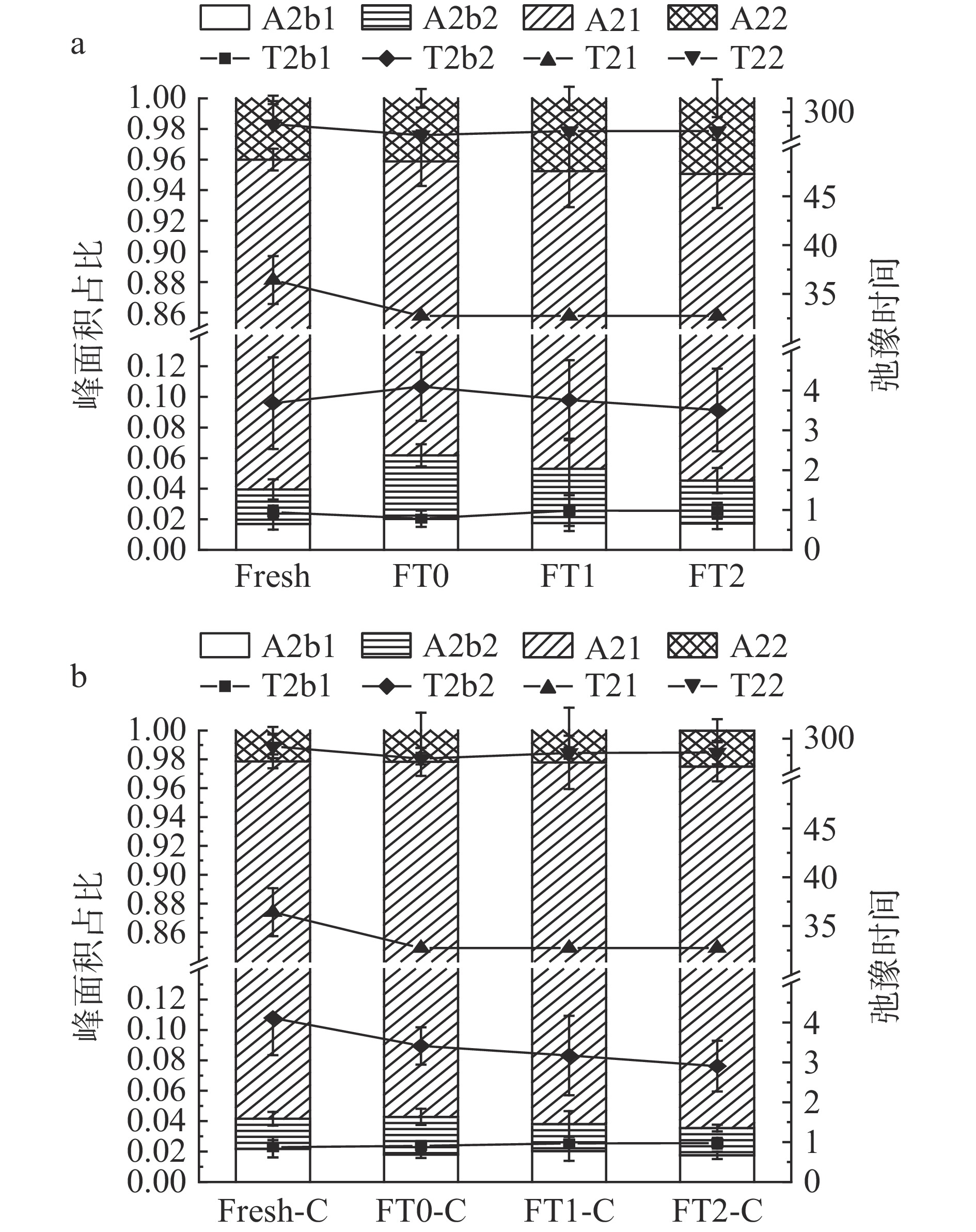
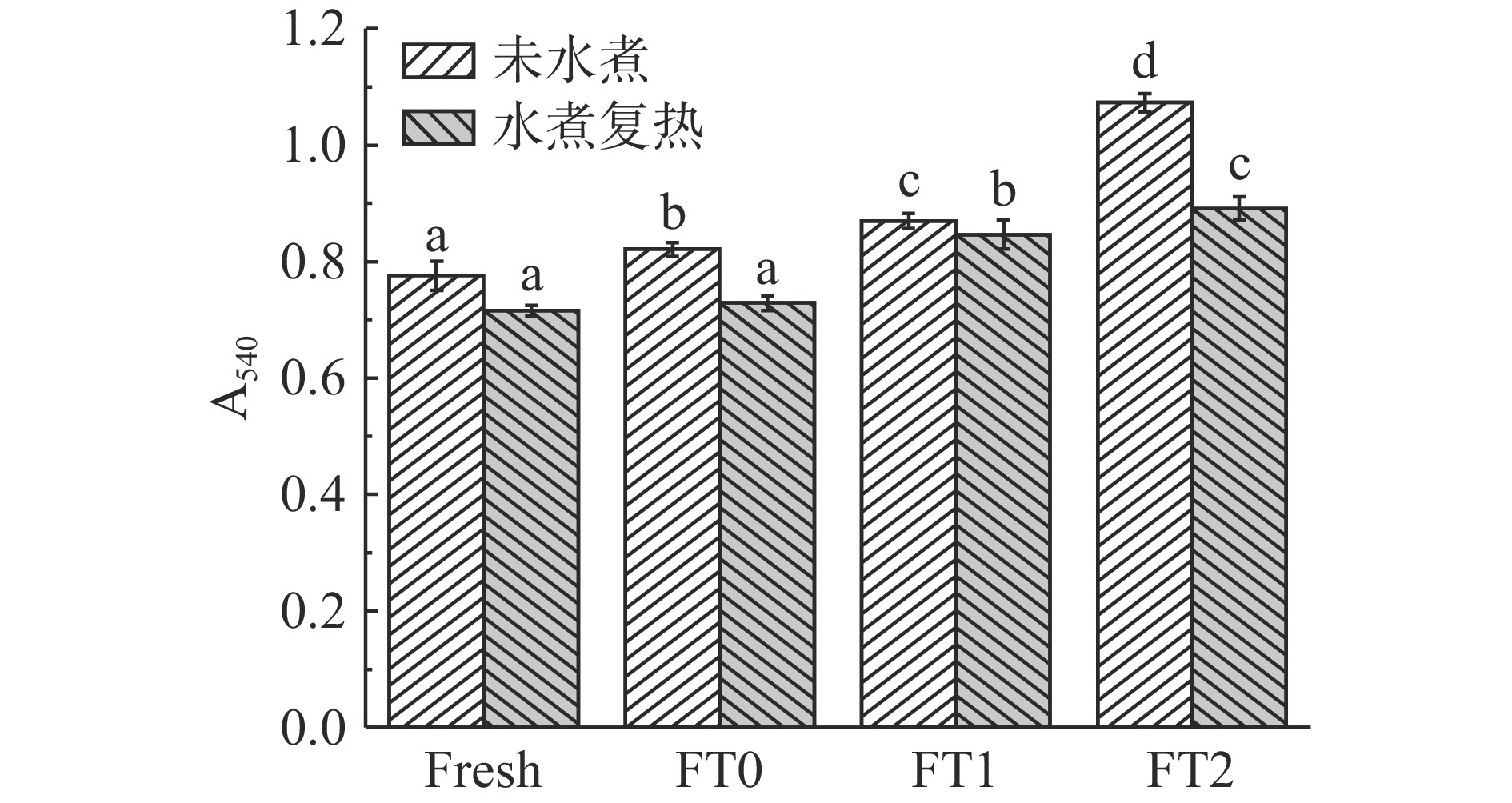

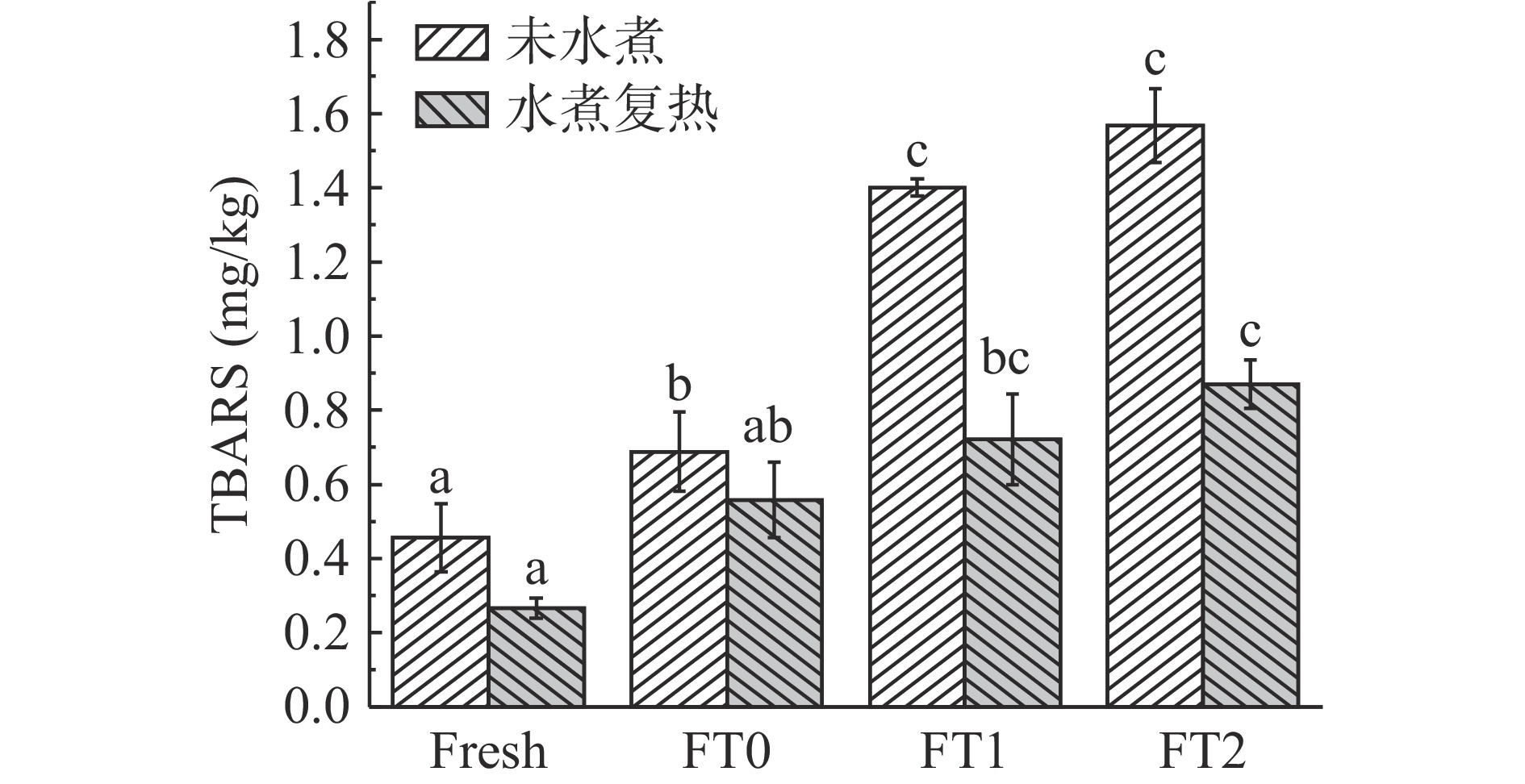
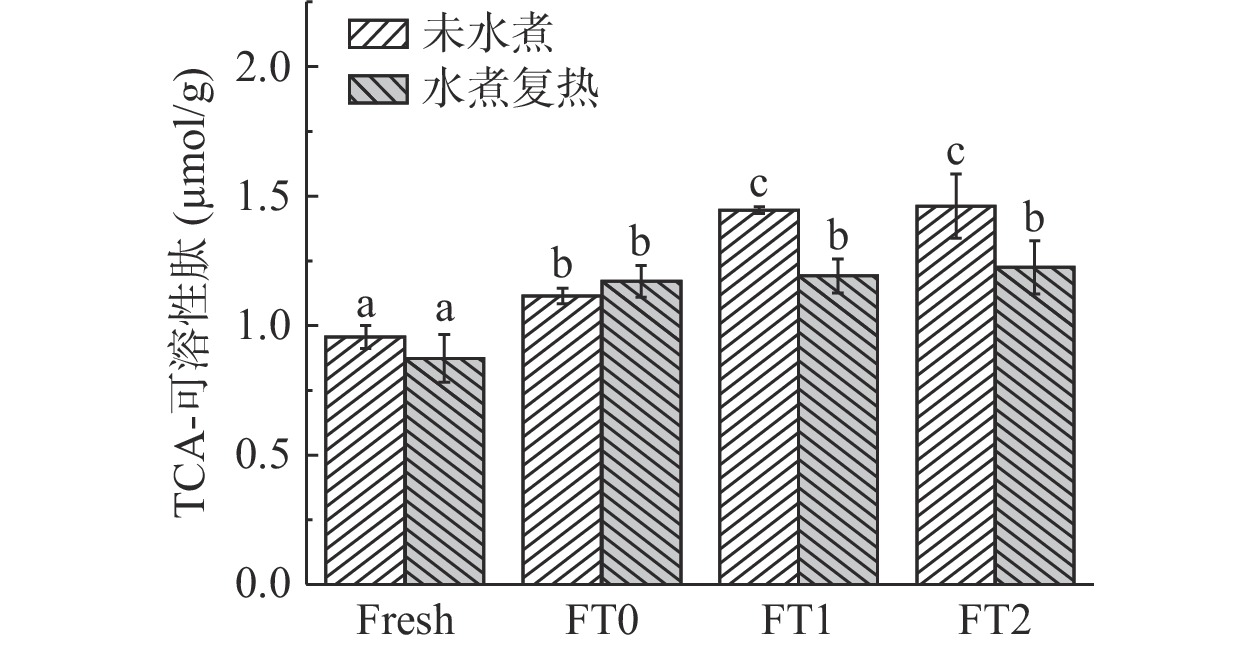
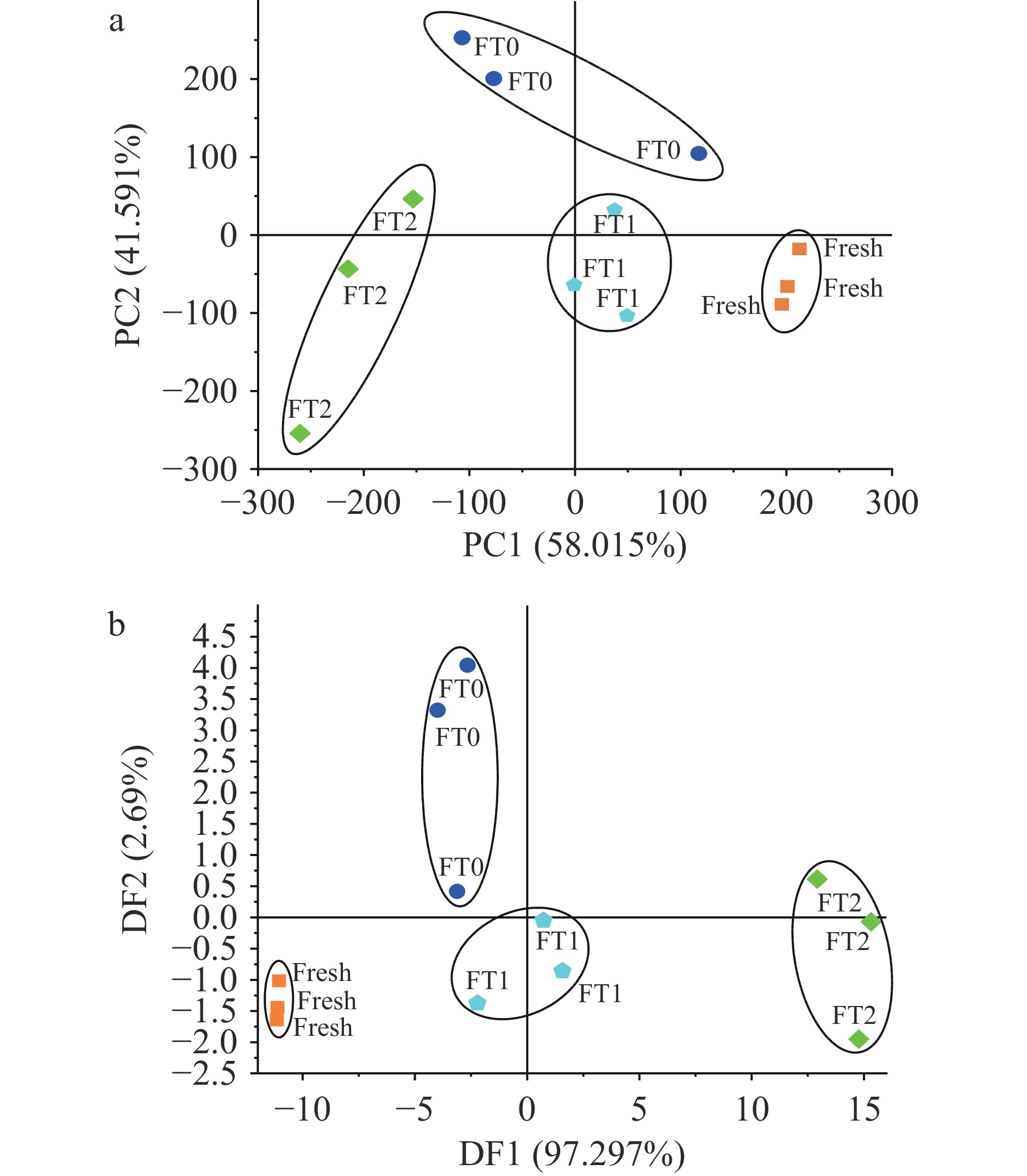
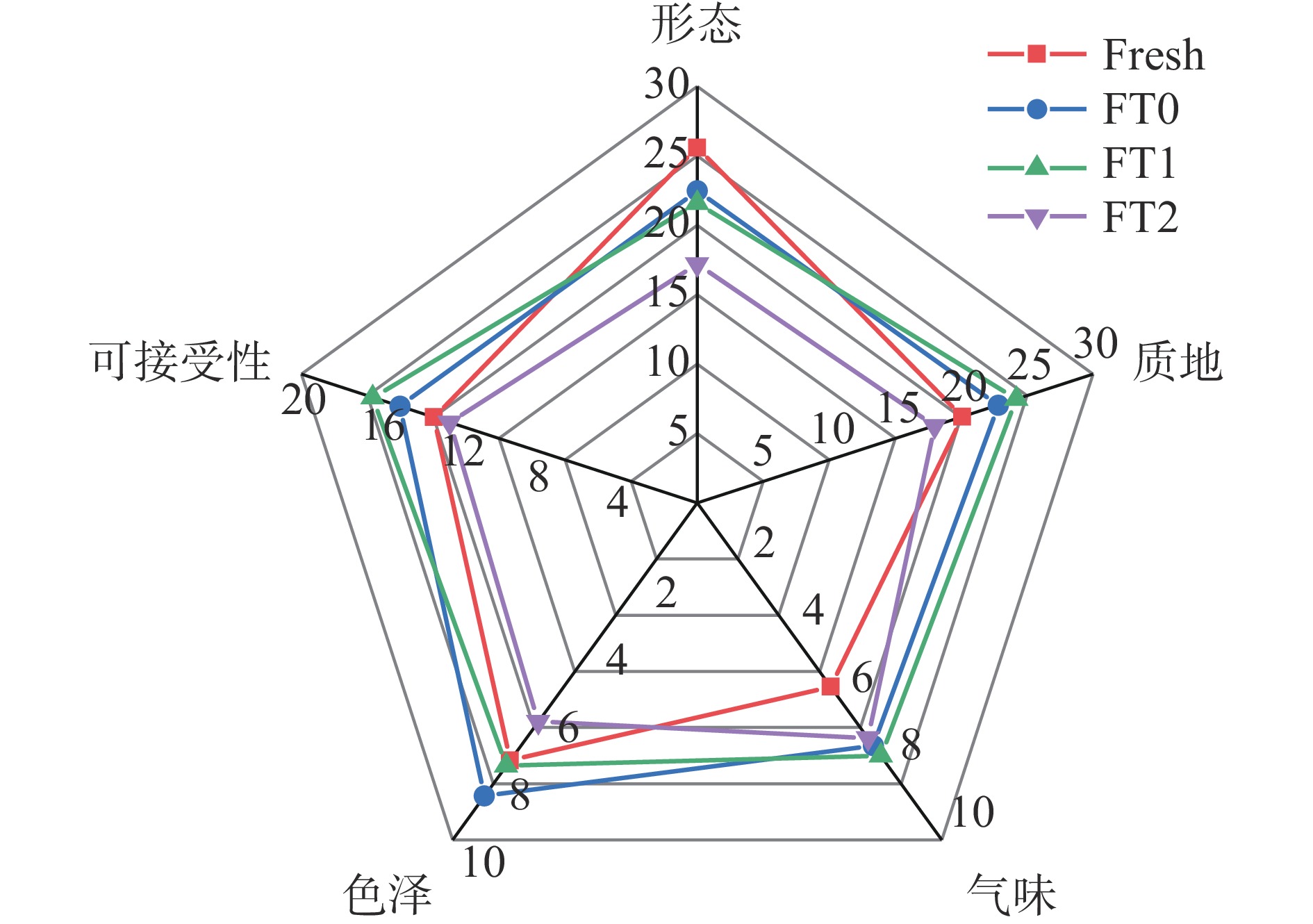
 下载:
下载:



